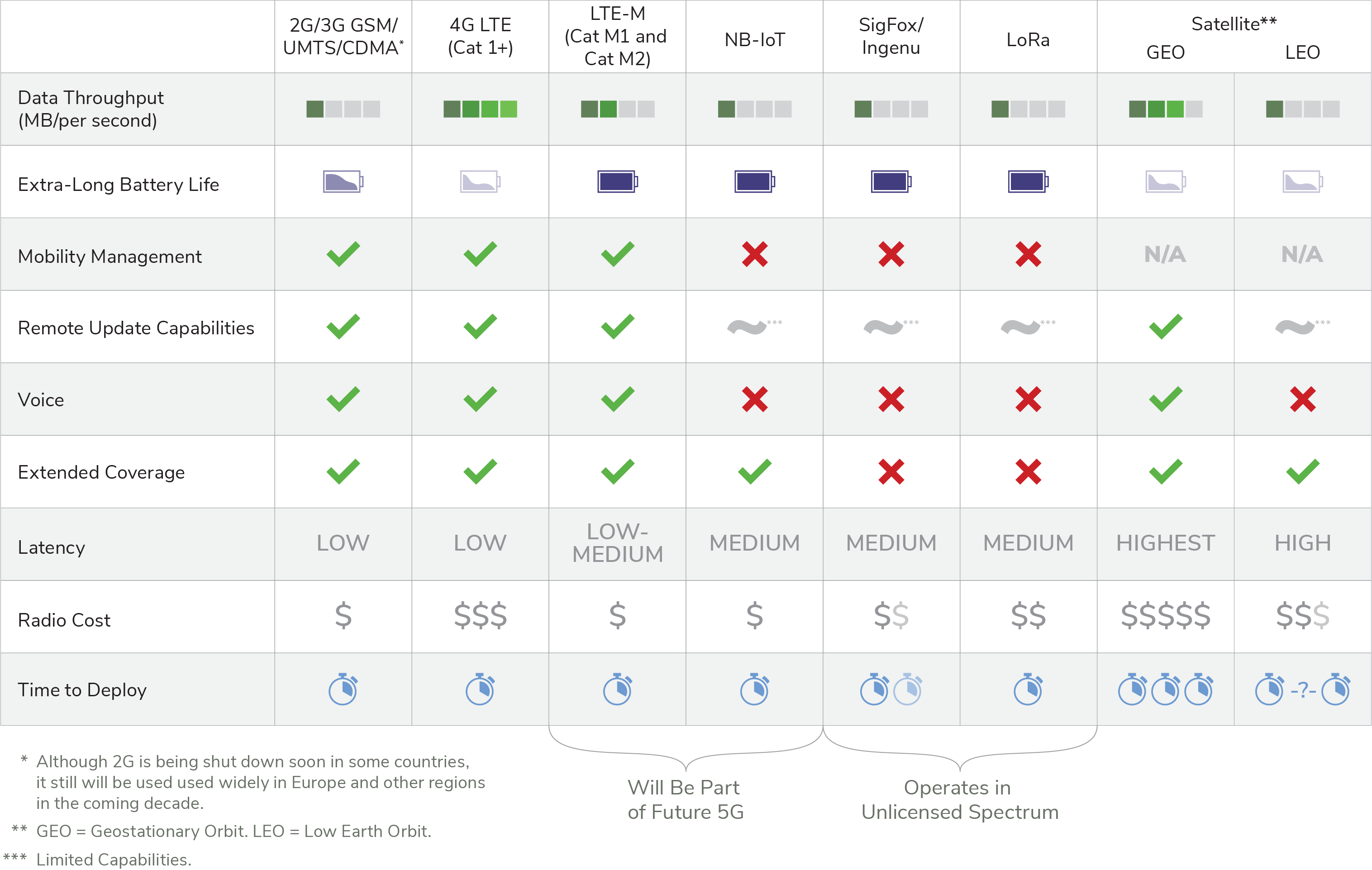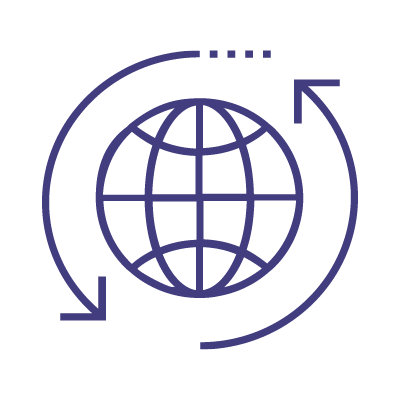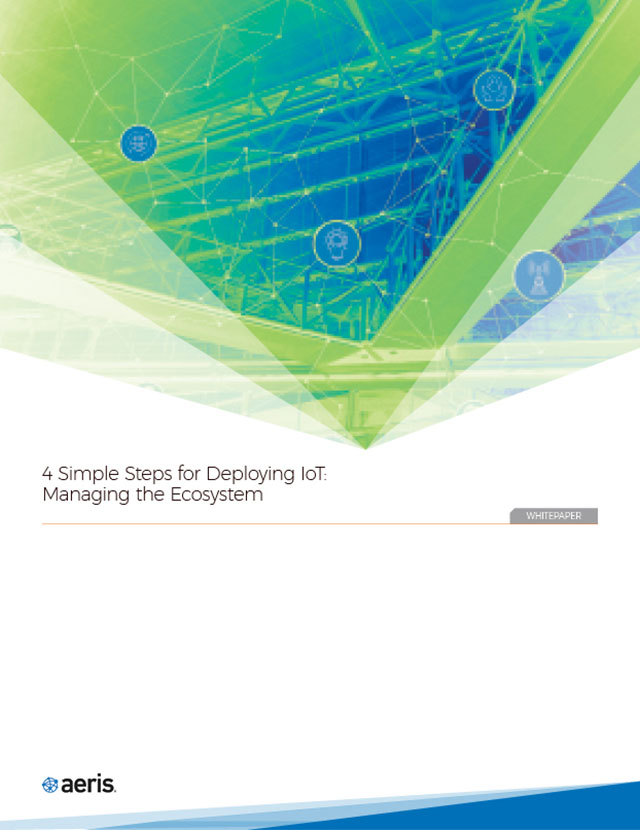If you haven’t figured out these four items before launch date, then trouble already is brewing and money surely is being wasted.
An IoT implementation might require a complex web of vendors and technologies to deliver and manage connectivity services as a key part of achieving a successful launch. For instance, connectivity providers, endpoint makers, gateway providers, vendors of IoT platform software, other software vendors, providers of data center capacity and management tools all need to come together to deliver an IoT service.
This paper will look at some of the basic needs for an IoT deployment, specifically focusing on the needed technology, the required coverage, a comprehensive level of support, as well as connectivity management so you know where money is being spent. Understanding these basic requirements before deployment calms the fears of those stepping into this new technological paradigm.

Your business has decided to power growth through the Internet of Things. But investing and planning new, large-scale projects can be overwhelming. Most businesses have expectations, mostly monetary, but are unsure of the steps to take to initiate such a deployment. Choosing the right partner, with expertise
and experience, can make or break initial projects.
Think of one platform to manage multiple technologies, with additional capabilities to identify problems faster, resolve issues quicker, and control costs at every stage of IoT device usage. You need a platform that provides complete control over your IoT / M2M programs through the entire device lifecycle―one that allows real-time visibility into device performance and traffic patterns, as well as a solution that enables cost controls through flexible alerts and alarms. These capabilities result in greater operational efficiencies, higher levels of automation, and ultimately, a much lower TCO.
Here are a few critical items to consider before the start of any IoT deployment.

Key to any IoT initiative is the need to understand the connectivity technologies available, as well as the best fit for your specific business needs. There are multiple options, depending on location, need, costs, etc. These include cellular connectivity from 2G* all the way up to soon-to-be delivered 5G. Technologies available include both proprietary and non-proprietary, each with strengths and weaknesses, each with differing functionality and price.
So, do you need a long-range wireless data transport capability that provides extensive coverage, is easy to configure/install, and is cost efficient? Cellular connectivity probably is the solution you seek. Why cellular? Two things. Cellular provides extensive coverage and is quick and easy to install without worrying about configuring either local ISPs or a Wi-Fi system or a firewall.
Basically, connectivity protocols can be broken into two overarching categories: standardized and proprietary. The differences between standardized (licensed) and proprietary (unlicensed) technologies are fairly basic. Standardized IoT connectivity runs in a managed spectrum, with existing cellular standards. Unlicensed, or proprietary technologies, run in an unmanaged spectrum. Examples such as SigFox, Ingenu, and LoRaWAN are intriguing innovations, but these networks only exist in a few cities. Unless you are developing a geographically constrained product, these networks likely won’t work for your solution.
For this paper, we will focus on the more widely used cellular protocols within the licensed group.
* 2G in some parts of the world still is available, sunsetting in 5-10 years. If your global product life cycle requires that you maintain service for at least 10 years, then 2G might not be a good choice.

Do not need real-time data?
NB-IoT will work perfectly well
Need voice for your IoT application?
LTE-M is the right choice
Longer battery life is essential?
NB-IoT and LTE-M both provide longer battery life than LTE
Need some real-time communication?
LTE-M has lower latency, higher throughput
Lowest cost radio for large scale?
NB-IoT and LTE-M have much lower module costs than LTE
Application is physically mobile?
LTE-M has mobility management support
Whether you pick a particular technology that is going to be used here in the United States or North America or perhaps over in Europe or in the Far East or Africa, you have choices to make due to the availability of technology, coverage areas, and overall costs. If you’re in the U.S., most likely you’re going to want to pick a family of 4G technologies, whether it’s LTE technologies that are in existence and deployed today, which are in the relatively high end for many applications, or some of the up-and-coming newer lower power, wide area (LPWA) network technologies, like LTE-M and NB-IoT. The idea is that you have options. You have to decide which is the best technology for you based on the criteria of your application requirements. Here are some insights to the newer protocols available.
LTE-M is a bi-directional, standards-based protocol within a dedicated spectrum. It provides carrier-grade security, long battery life, low data needs, and low-cost modules. One of the strengths of LTE-M is that it does not need a new infrastructure as it can piggyback on existing LTE networks. What that means is that a carrier can update software on its network, get LTE-M functional, and not spend any additional funds on infrastructure or support services.
Additionally, data collection devices can transmit data on a non-continuous schedule, as set by the end user. The device, when not sending data is not off, but just asleep. When data is scheduled to be sent, the device does not need to be re-activated to join the network, it just wakes up. Having intermittent data send-schedules, which are not active 24x7, can save battery life, leading to significant
cost savings.
NB-IoT is a standards-based LPWA IoT technology. It has a global reach with better bi-directional data than any of its unlicensed counterparts. And, unlike LTE-M, NB-IoT is based on Direct Sequence Spread Spectrum (DSSS) modulation, which ‘widens’ the signal so as to reduce interference. It also might make it a bit harder to go national (since it can’t yet hook into the LTE network). NB-IoT is supported by all major mobile equipment manufacturers and can work with 2G, 3G, and 4G mobile networks, so it enjoys the heightened security of mobile networks, including user ID, authentication, data integrity, and more.
The NB-IoT LPWA solution is optimized for applications that need to communicate small amounts of data over long periods of time. Because of its point-to-point topology, NB-IoT results in lower latency with a higher transmit power limit (200 kHz bandwidth), which improves range and reliability, even underground or inside buildings. And since it operates in a licensed spectrum, it is secure with highly reliable data transmission, assuring a high quality of service. With its simpler underlying technology, costs for NB-IoT modules will continue to decrease as demand increases.
In Comparison |
|
|
NB-IoT
Use case: |
LTE-M
Use case: |
5G, when fully deployed, will support high-end smartphone users and a whole lot more. It will speed up downloads, do real-time map updates in autonomous vehicles, as well as an assortment of high-performance functions. 5G will better consolidate the network for all kinds of cellular technologies, making the network more uniform, managing differing technologies, such as NB-IoT or LTE-M, in the same way so they all can co-exist. The major problem with 5G is that it is not yet widely available. But if the reality lives up to the hype, 5G will change the IoT landscape once again.
So, your technology choices will reflect specific needs. Are you focused on cost and coverage? Is mobility an issue or are your devices stationary for a very long time? Do you need voice functionality? You have to decide on the technology that is best suited for you based on the criteria of your application requirements.

Maintaining always-on connectivity coverage should be a starting point for your deployment. Without it, deployments suffer increased downtime, coverage costs go up, and thought out business plans become far less effective. The overriding solution to this is multi-provider, multi-technology coverage that ensures your business always can be connected to the strongest signals, regardless of location.
Aeris offers 2G, 3G, 4G, and soon-to-be 5G cellular connectivity in more than 180 countries across more than 550 carriers. Our networks are built specifically for IoT, and include readiness for next-generation technologies, such as LTE-M and NB-IoT, for increased coverage. At present, there are more than 14 million devices on our network, using protocols such as:
LTE Data Coverage: Aeris provides your company with access to leading nationwide 4G LTE connectivity, optimized with 3G fallback capabilities.
CDMA Data Coverage: With access to more than 50 North American CDMA carriers, Aeris provides ubiquitous coverage to your devices, ensuring you can send and receive data as needed.
GSM Data Coverage: With more than 400 partners across 180 countries, Aeris provides worldwide connectivity with unmatched depth of coverage to your devices.

Maximizing global support is becoming a turning point for IoT organizations. Support and troubleshooting for an IoT deployment can consist of several areas of importance, including onboarding and deployment support; help desk assistance; response times; proactive problem notifications; and 24/7 online and automated information services. Support levels can break or make a deal or, in a worse-case scenario, can force customers to switch providers. A good support infrastructure will catch issues before they impact your business, thereby lessening troubleshooting times while maintaining maximum deployment uptime. Empowering users, conserving resources, and accelerating time to market is becoming a major differentiator for IoT platform providers.
Aeris is dedicated to ensuring that your devices and applications work on the Aeris Fusion IoT Network at the level that meets your business M2M communication needs. Aeris has developed Infinity Support™ to provide the critical capabilities you need to achieve breakthrough performance in operational efficiency and solution uptime.

All enterprise customers automatically receive Infinity Support.
Once you have deployed connected devices, the next most important thing to know is whether the devices and sensors are working properly. Issues that need
to be addresses include:
Do I have proactive identification of usage and billing issues?
Do I have easy access to connectivity data?
Can I employ remote diagnosis and support?
Is there a simple-to-use interface to diagnose issues quickly?
How do I manage devices connected to different carriers?
Using differing technologies?
Aeris AerPort, a comprehensive connectivity management platform, provides the cost-saving controls needed throughout the entire device lifecycle. Using the AerPort platform, companies can gain timely insights, proactively identify usage and billing issues, and take positive actions based on real-time data, thereby reducing the total cost of ownership.
Digging deeper, Aeris AerPort allows you to identify problem devices faster; resolve connectivity issues proactively; control costs throughout the supply chain; and is completely carrier and technology agnostic. One platform providing one view of your entire deployment, regardless of carrier, device location, or the connectivity technology used.
The AerPort platform provides a single interface to manage and monitor usage across all deployed devices, regardless of the underlying carrier, whether through the AerPort portal or through Aeris APIs. Combining real-time data with actionable, cost-saving device controls provides management oversight throughout the device lifecycle.
Aeris has been successful in creating a unique IoT ecosystem for enterprises, original equipment manufacturers (OEMs), technologists, system integrators, and solution providers in multiple vertical sectors. With our set of comprehensive IoT solutions and services, organizations can optimize IoT deployments and have real-time remote monitoring of machines, things, equipment, and assets.
At Aeris, we believe that the future will see the expansion of NB-IoT and LTE-M over the other proprietary LPWA technologies in the field. One of the reasons will be cost. Another will be coverage. Like LTE-M, network upgrades will enable NB-IoT growth through already existing towers, making it an IoT force to be reckoned with.
The issue for companies will be to decide whether to be locked into a low-cost, proprietary system or to go with an IoT service provider linked into multiple carriers, thus providing seamless reliable, low-cost connectivity coverage.



